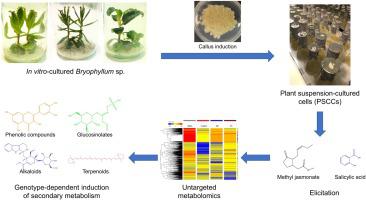Industrial Crops and Products ( IF 5.6 ) Pub Date : 2021-02-15 , DOI: 10.1016/j.indcrop.2021.113322 Pascual García-Pérez , Begoña Miras-Moreno , Luigi Lucini , Pedro P. Gallego

|
In this work, the combination of elicited plant suspension cultured cells (PSCCs) with untargeted metabolomics establishes a powerful, cutting-edge strategy to unravel the effects of elicitors on the biosynthetic potential of medicinal plants, as Bryophyllum sp. The PSCC technology constitutes a successful biotechnological system for the study and production of bioactive compounds throughout the inclusion of elicitors with the ability to modulate secondary metabolism. The use of methyl jasmonate (MJ) and salicylic acid (SA) as abiotic elicitors on bryophyllum PSCCs, resulted in differential effects on cell growth and secondary metabolism, depending on the species, including synergistic and antagonistic effects. This fact suggests that both elicitors play a pleiotropic effect on plant secondary metabolism, showing complex interactions, according to the UHPLC-QTOF mass spectrometry profiling. Thus, the combination of both elicitors induced a strong synergistic on B. daigremontianum PSCCs, with 2272 putatively annotated compounds, whereas it caused a negative effect on the secondary metabolism of B. × houghtonii PSCCs, being MJ the only elicitor driving a positive effect, presenting 2972 annotated compounds. Meanwhile, B. tubiflorum PSCCs did not show a significant modulation of secondary metabolism, with 1521 annotated compounds. The metabolite annotation indicated that three families of secondary metabolites were mainly affected by elicitation: phenolic compounds constituted the most affected family by elicitation, mainly represented by flavonoids and lignans; N-containing compounds included glucosinolates, amines, and alkaloids, reported to Bryophyllum sp. for the first time; and terpenoids included mainly phytoalexins and saponins. The results depict a deep genotype-dependent metabolomic reprogramming of secondary metabolism in response to elicitors, thanks to the application of untargeted metabolomics. This knowledge will allow the consideration of Bryophyllum sp. as a valuable source of bioactive compounds, with the potential associated to PSCCs, for being included in food, cosmetic, and pharmaceutical applications.
中文翻译:

代谢组学揭示了在3个苔藓植物悬浮细胞培养物中生物活性化合物的种内变异性
在这项工作中,引起植物悬浮液的组合培养的细胞(PSCCs)与非靶向代谢物组学建立一个强大的,尖端策略解开药用植物的生物合成诱导子的潜在的影响,如Bryophyllumsp。PSCC技术构成了一个成功的生物技术体系,用于研究和生产具有调节二次代谢能力的引发剂的生物活性化合物。茉莉酸甲酯(MJ)和水杨酸(SA)作为对苔藓植物PSCC的非生物引发剂的使用,对细胞生长和次级代谢产生不同的影响,具体取决于物种,包括协同作用和拮抗作用。根据UHPLC-QTOF质谱分析,此事实表明两种激发子均对植物的次生代谢发挥多效性,表现出复杂的相互作用。因此,两种引发剂的组合对B. daigremontianum产生了强烈的协同作用。PSCC具有2272个带注释的化合物,而它对B.× Houghtonii PSCC的二次代谢产生了负面影响,是MJ唯一引起正效应的引发剂,提供了2972个带注释的化合物。同时,小花芽孢杆菌PSCC没有显示出二次代谢的显着调节,带有1521个带注释的化合物。代谢物注释表明,三个次生代谢物家族主要受到诱导作用的影响:酚类化合物受诱导作用影响最大,主要是类黄酮和木脂素。据报道,Bryophyllum含N的化合物包括芥子油苷,胺和生物碱sp。首次; 萜类化合物主要包括植物抗毒素和皂苷。结果表明,由于应用了非靶向代谢组学技术,对次级代谢的二次代谢产生了深层次的基因型依赖性代谢组学重编程。这些知识将使人们可以考虑对苔藓菌属进行鉴定。作为生物活性化合物的重要来源,具有与PSCC相关的潜力,可用于食品,化妆品和制药应用中。











































 京公网安备 11010802027423号
京公网安备 11010802027423号